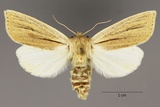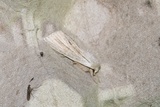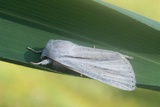Simyra albovenosa (Goeze, 1781) Species
Last modified: Nov. 18, 2025, 2:42 p.m.
A rare but widespread species in Belgium. Most observations in the northern part of the country.
This species is considered Endangered according to the IUCN Red List category for Flanders 2023.
Details
- Classification
- Family: Noctuidae > Subfamily: Acronictinae > Genus: Simyra > Species: Simyra albovenosa
- Vernacular names
- Kleine rietvink (NL), Reed Dagger (EN), La Noctuelle veineuse (FR), Ried-Weißstriemeneule (DE)
- First mention in Belgium
- Anonymous 1902. Varia. — Revue mensuelle de la Société entomologique namuroise 2: 4, 12. On page 12.
- Status
-
Native
Distribution
Bionomics
Hibernates as a pupa, in a cocoon among living reed foliage or debris on or near the ground.
The adults are active from dusk onwards and later come to light.
Flight periods
The adults fly in two generations a year from April till mid-September. Very occasionally a partial third generation occurs in October.
Observed on
- Host plant (species):
- Phragmites australis, Lysimachia vulgaris, Carex elata, Catabrosa aquatica and Rumex hydrolapathum
- Host plant (genera):
- Salix
The larva lives mainly on Phragmites australis but also on other plants of wet habitats like Lysimachia vulgaris, Rumex hydrolapathum, Cladium mariscus, Carex paniculata and Salix.





